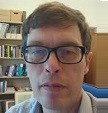1.4: Wave particle duality
( \newcommand{\kernel}{\mathrm{null}\,}\)
If waves (light) can be particles (photons), can particles (electrons, etc.) be waves? de Broglie gave a positive answer to this question, and argued that for a particle with energy E and momentum p
E=hνp=hλ
where v and λ are the frequency and the wavelength, respectively. These are exactly the relations for a photon.

One way to show that this behaviour is the correct one is to do the standard double slit experiment. For light we know that we have constructive or destructive interference if the difference in the distance traveled between two waves reaching the same point is a integer (integer plus one half) times the wavelength of the light. With particles we would normally expect them to travel through one or the other of each of the slits. If we do the experiment with a lot of particles, we actually see the well known double-slit interference.


